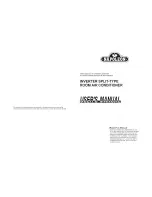
29
11.4.3.
EVACUATION OF THE EQUIPMENT
WHEN INSTALLING AN AIR CONDITIONER, BE SURE TO EVACUATE THE AIR INSIDE THE INDOOR UNIT AND PIPES in the
following procedure.
1. Connect a charging hose with a push pin to the Low side of a charging set and the service port of the 3-way valve.
• Be sure to connect the end of the charging hose with the push pin to the service port.
2. Connect the center hose of the charging set to a vacuum pump.
3. Turn on the power switch of the vacuum pump and make sure that the needle in the gauge moves from 0 cmHg (0 MPa) to
-76 cmHg (-0.1 MPa). Then evacuate the air approximately ten minutes.
4. Close the Low side valve of the charging set and turn off the vacuum pump. Make sure that the needle in the gauge does not
move after approximately five minutes.
Note: BE SURE TO TAKE THIS PROCEDURE IN ORDER TO AVOID REFRIGERANT GAS LEAKAGE.
5. Disconnect the charging hose from the vacuum pump and from the service port of the 3-way valve.
6. Tighten the service port caps of the 3-way valve at a torque of 18 N
O
m with a torque wrench.
7. Remove the valve caps of both of the 2-way valve and 3-way valve. Position both of the valves to “OPEN” using a hexagonal
wrench (4 mm).
8. Mount valve caps onto the 2-way valve and the 3-way valve.
• Be sure to check for gas leakage.
11.4.4.
CONNECT THE CABLE TO THE OUTDOOR UNIT
1. Remove the control board cover from the unit by loosening the screw.
2. Connecting cable between indoor unit and outdoor unit shall be approved polychloroprene sheathed 3 (C7HKD, C9HKD,
C12HKD) or 5 (A7HKD, A9HKD, A12HKD) x 1.5 mm
2
flexible cord, type designation 245 IEC 57 or heavier cord.
3. Secure the cable onto the control board with the holder (clamper).
CAUTION
• If gauge needle does not move from 0 cmHg (0 MPa) to -76 cmHg (-0.1 MPa), in step
above take the following measure:
• If the leak stops when the piping connections are tightened further, continue working from step
.
• If the leak does not stop when the connections are retightened, repair the location of leak.
• Do not release refrigerant during piping work for installation and reinstallation. Take care of the liquid refrigerant, it may cause frostbite.
Содержание CS-A12HKD
Страница 12: ...12 4 Location of Controls and Components 4 1 Indoor Unit 4 2 Outdoor Unit 4 3 Outdoor Unit ...
Страница 13: ...13 5 Dimensions 5 1 Indoor Unit Remote Control 5 1 1 CS A7HKD CS A9HKD CS A12HKD ...
Страница 14: ...14 5 2 Outdoor Unit 5 2 1 CU A7HKD CU A9HKD 5 2 2 CU A12HKD ...
Страница 15: ...15 6 Refrigeration Cycle Diagram ...
Страница 16: ...16 7 Block Diagram 7 1 CS A7HKD CU A7HKD CS A9HKD CU A9HKD ...
Страница 17: ...17 7 2 CS A12HKD CU A12HKD ...
Страница 20: ...20 9 Electronic Circuit Diagram ...
Страница 21: ...21 10 Printed Circuit Board 10 1 Main Printed Circuit Board ...
Страница 22: ...22 10 2 Power Printed Circuit Board TOP VIEW BOTTOM VIEW ...
Страница 23: ...23 10 3 Indicator Printed Circuit Board 10 4 Patrol Printed Circuit Board ...
Страница 26: ...26 3 For the embedded piping This can be used for left rear piping and left bottom piping also ...
Страница 51: ...51 Normal Deice Time Diagram Overload Deice Time Diagram ...
Страница 57: ...57 ...
Страница 58: ...58 16 2 Indoor Fan Motor and Cross Flow Fan Removal Procedures ...
Страница 59: ...59 ...
Страница 60: ...60 17 Technical Data 17 1 Thermostat Characteristics Cooling Soft Dry Heating ...
Страница 61: ...61 17 2 Operation Characteristics 17 2 1 CS A7HKD CU A7HKD ...
Страница 62: ...62 ...
Страница 63: ...63 ...
Страница 64: ...64 ...
Страница 65: ...65 17 2 2 CS A9HKD CU A9HKD ...
Страница 66: ...66 ...
Страница 67: ...67 ...
Страница 68: ...68 ...
Страница 69: ...69 17 2 3 CS A12HKD CU A12HKD ...
Страница 70: ...70 ...
Страница 71: ...71 ...
Страница 72: ...72 ...
















































